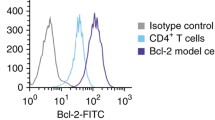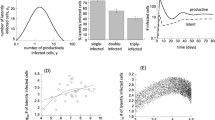Abstract
HIV-1 establishes latency primarily by infecting activated CD4+ T cells that later return to quiescence as memory cells. Latency allows HIV-1 to evade immune responses and to persist during antiretroviral therapy, which represents an important problem in clinical practice. Here we describe both the original and a simplified version of HIV-1 latency models that mimics this process using replication competent viruses. Our model allows generation of large numbers of latently infected CD4+ T cell to dissect molecular mechanisms of HIV latency and reactivation.
Access this chapter
Tax calculation will be finalised at checkout
Purchases are for personal use only
Similar content being viewed by others
References
Tyagi M, Romerio F (2011) Models of HIV-1 persistence in the CD4+ T cell compartment: past, present and future. Curr HIV Res 9(8):579–587
Harper ME, Marselle LM, Gallo RC, Wong-Staal F (1986) Detection of lymphocytes expressing human T-lymphotropic virus type III in lymph nodes and peripheral blood from infected individuals by in situ hybridization. Proc Natl Acad Sci U S A 83(3):772–776
Chun TW, Finzi D, Margolick J, Chadwick K, Schwartz D, Siliciano RF (1995) In vivo fate of HIV-1-infected T cells: quantitative analysis of the transition to stable latency. Nat Med 1(12):1284–1290
Finzi D, Hermankova M, Pierson T, Carruth LM, Buck C, Chaisson RE, Quinn TC, Chadwick K, Margolick J, Brookmeyer R, Gallant J, Markowitz M, Ho DD, Richman DD, Siliciano RF (1997) Identification of a reservoir for HIV-1 in patients on highly active antiretroviral therapy. Science 278(5341):1295–1300
Chun TW, Stuyver L, Mizell SB, Ehler LA, Mican JA, Baseler M, Lloyd AL, Nowak MA, Fauci AS (1997) Presence of an inducible HIV-1 latent reservoir during highly active antiretroviral therapy. Proc Natl Acad Sci U S A 94(24):13193–13197. https://doi.org/10.1073/pnas.94.24.13193
Wong JK, Hezareh M, Gunthard HF, Havlir DV, Ignacio CC, Spina CA, Richman DD (1997) Recovery of replication-competent HIV despite prolonged suppression of plasma viremia. Science 278(5341):1291–1295
Finzi D, Blankson J, Siliciano JD, Margolick JB, Chadwick K, Pierson T, Smith K, Lisziewicz J, Lori F, Flexner C, Quinn TC, Chaisson RE, Rosenberg E, Walker B, Gange S, Gallant J, Siliciano RF (1999) Latent infection of CD4+ T cells provides a mechanism for lifelong persistence of HIV-1, even in patients on effective combination therapy. Nat Med 5(5):512–517. https://doi.org/10.1038/8394
Han Y, Wind-Rotolo M, Yang HC, Siliciano JD, Siliciano RF (2007) Experimental approaches to the study of HIV-1 latency. Nat Rev Microbiol 5(2):95–106. https://doi.org/10.1038/nrmicro1580
Jenkins MK, Khoruts A, Ingulli E, Mueller DL, McSorley SJ, Reinhardt RL, Itano A, Pape KA (2001) In vivo activation of antigen-specific CD4 T cells. Annu Rev Immunol 19:23–45. https://doi.org/10.1146/annurev.immunol.19.1.23
Marrack P, Kappler J (2004) Control of T cell viability. Annu Rev Immunol 22:765–787. https://doi.org/10.1146/annurev.immunol.22.012703.104554
Bradley LM, Haynes L, Swain SL (2005) IL-7: maintaining T-cell memory and achieving homeostasis. Trends Immunol 26(3):172–176. https://doi.org/10.1016/j.it.2005.01.004
Swain SL, Agrewala JN, Brown DM, Jelley-Gibbs DM, Golech S, Huston G, Jones SC, Kamperschroer C, Lee WH, McKinstry KK, Roman E, Strutt T, Weng NP (2006) CD4+ T-cell memory: generation and multi-faceted roles for CD4+ T cells in protective immunity to influenza. Immunol Rev 211:8–22. https://doi.org/10.1111/j.0105-2896.2006.00388.x
Khaled AR, Durum SK (2003) Death and Baxes: mechanisms of lymphotrophic cytokines. Immunol Rev 193:48–57
Margolick JB, Volkman DJ, Folks TM, Fauci AS (1987) Amplification of HTLV-III/LAV infection by antigen-induced activation of T cells and direct suppression by virus of lymphocyte blastogenic responses. J Immunol 138(6):1719–1723
Zack JA, Cann AJ, Lugo JP, Chen IS (1988) HIV-1 production from infected peripheral blood T cells after HTLV-I induced mitogenic stimulation. Science 240(4855):1026–1029
Hermankova M, Siliciano JD, Zhou Y, Monie D, Chadwick K, Margolick JB, Quinn TC, Siliciano RF (2003) Analysis of human immunodeficiency virus type 1 gene expression in latently infected resting CD4+ T lymphocytes in vivo. J Virol 77(13):7383–7392. https://doi.org/10.1128/jvi.77.13.7383-7392.2003
Lassen KG, Bailey JR, Siliciano RF (2004) Analysis of human immunodeficiency virus type 1 transcriptional elongation in resting CD4+ T cells in vivo. J Virol 78(17):9105–9114. https://doi.org/10.1128/JVI.78.17.9105-9114.2004
Marini A, Harper JM, Romerio F (2008) An in vitro system to model the establishment and reactivation of HIV-1 latency. J Immunol 181(11):7713–7720
Iglesias-Ussel M, Marchionni L, Romerio F (2013) Isolation of microarray-quality RNA from primary human cells after intracellular immunostaining and fluorescence-activated cell sorting. J Immunol Methods 391(1–2):22–30. https://doi.org/10.1016/j.jim.2013.02.003
Iglesias-Ussel M, Vandergeeten C, Marchionni L, Chomont N, Romerio F (2013) High levels of CD2 expression identify HIV-1 latently infected resting memory CD4+ T cells in virally suppressed subjects. J Virol 87(16):9148–9158. https://doi.org/10.1128/JVI.01297-13
Acknowledgments
This work was supported by the National Institute of Health grants R21AI084711 and R21AI106508 (to F.R.). The authors would like to thank Zahra Gholizadeh for helpful discussion.
Author information
Authors and Affiliations
Corresponding author
Editor information
Editors and Affiliations
Rights and permissions
Copyright information
© 2022 Springer Science+Business Media, LLC, part of Springer Nature
About this protocol
Cite this protocol
Li, R., Romerio, F. (2022). An In Vitro System to Model the Establishment and Reactivation of HIV-1 Latency in Primary Human CD4+ T Cells. In: Poli, G., Vicenzi, E., Romerio, F. (eds) HIV Reservoirs. Methods in Molecular Biology, vol 2407. Humana, New York, NY. https://doi.org/10.1007/978-1-0716-1871-4_3
Download citation
DOI: https://doi.org/10.1007/978-1-0716-1871-4_3
Published:
Publisher Name: Humana, New York, NY
Print ISBN: 978-1-0716-1870-7
Online ISBN: 978-1-0716-1871-4
eBook Packages: Springer Protocols




